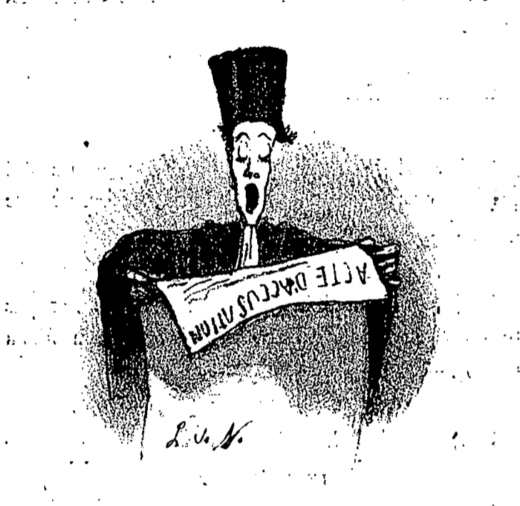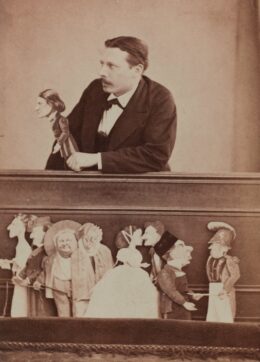
Printed
43 pages
Author(s)
Le Procès Belenfant-des-Dames
The play Le Procès Belenfant-des-Dames (The Trial of Belenfant-des-Dames) is part of the volume Paris-Pantin : deuxième série des “Pupazzi” (Paris-Puppet: second instalment of the “Pupazzi”) published in 1868. In this book, the plays are preceded by several prologues, often improvised by Lemercier de Neuville before his performances.
As was the case in the two instalments of the first Pupazzi series (1866), the author includes contemplations on his time, portraits of personalities and accounts of recent events. The play features a series of entries from these characters, using the initial concept of Lemercier de Neuville’s performances: a series of caricatures punctuated by short lines. It included figures like the painter Gustave Courbet, the Italian composer Gioachino Rossini, the mathematician and illusionist Alfred de Caston, the journalist Émile de Girardin, the writer Alexandre Dumas, the former president of the Conseil des ministres (Council of Ministers) Jules Simon, and the former president of the French Republic Adolphe Thiers. All are introduced in a satirical and comical way.
This satirical play is made of four tableaux and mixes absurdity with judicial parody.
Characters with no connection to the case testify in a trial
Madame Pifardent (literally, Madame Fiery-snout) has been disfigured by sulfuric acid, and a trial ensues to find the culprit. The accused, Émile Belenfant-des-Dames, who is described as “the worst kind of villain, already sentenced to death in absentia nine times”, has been arrested at the Belgian border, 600 kilometres away from the crime scene at the time when it was committed. The Greffier (Court clerk) assures that Belenfant could have covered this distance thanks to the miracles of the railway. Belenfant denies any connection to Madame Pifardent and claims to be innocent.
The witnesses are called. Gustave Courbet says that he only knows his paintings. He digresses and talks about the woman he would marry: a woman who could barely read and write, who would not know how to dance and who would wear a straw hat. Gioachino Rossini, who knows nothing about the case, talks about the “macaroni dell’arte”. After him, Alfred de Caston performs a magic trick with cards and dominoes. He leaves the room to the applause.
Then, Émile de Girardin speaks; he talks about freedom, peace, his writing and especially his drama Le Supplice d’une femme (The Torture of a woman). He quickly disappears. Alexandre Dumas senior only talks about his accomplishments. Jules Simon, dressed as a primary school teacher, arrives. He passionately discusses the importance of education and of schools, and then leaves. Adolphe Thiers goes after him and talks about his duty. The last witness, the docteur Tardieu (Doctor Tardieu) describes his science experiments on frogs using sulfuric acid.
Madame Pifardent’s lawyer, Maître Favre, starts the pleas with a grandiloquent speech filled with metaphors. Then, the accused’s lawyer, Maître Lachaud, starts talking. He accuses Belenfant by recounting his past crimes. To defend himself, Belenfant retorts that those wrongdoings date back to the time of Louis Philippe. He also tries to justify his actions with his lack of education, and explains that he comes from a poor family. The Juge (Judge) interrupts him and forbids him from giving a “philosophical” speech. M. Prudhomme, the foreman of the jury, announces the verdict: the accused is found not guilty. Belenfant demands that a lament be sung in his honour. Before this, M. Prudhomme offers him to… marry his daughter.
Publications and translations
Lemercier de Neuville, Paris pantin : deuxième série des "Pupazzi", Paris : A. Lacroix, Verboeckhoven, 1868.
